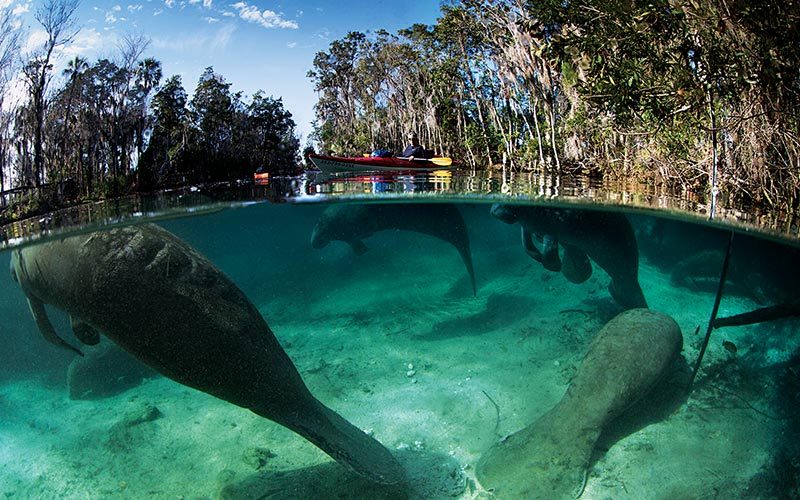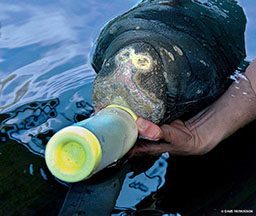Like many kids who grew up in Florida decades ago, my earliest interactions with manatees just … happened, and they did so quietly with a minimum of fuss. The first “sea cow” I encountered simply snuffled toward me in the St. John’s River while I swam near my parents’ dock. And the last time I traveled to Crystal River (this is where I date myself), it was a serene destination with a tiny dive operation or two, a couple of local hotels and a few snorkelers floating blessedly far apart from one another. Manatees had plenty of room to approach humans — or not — as they foraged in peace. It’s hard to believe that this area and this creature are now the focus of contention.
But things change, even in Crystal River. Between 2000 and 2010, Citrus County (which encompasses Crystal River) saw a population increase of more than 19 percent, which undoubtedly included many new residents dreaming of tranquil days on or near the water. Local ecotourism has grown even more. Florida’s manatees gather every winter near freshwater springs and power-plant outflows where the water is warm (a constant 72°F) compared with ocean and air temperatures. Crystal River’s Three Sisters Springs has the greatest freshwater outflow in the area and a correspondingly large wintertime manatee population. Visitors swarm the area to visit the gentle, goofy-looking marine mammals that are a symbol of Florida’s wildlife conservation efforts. Three Sisters drew more than eight times as many visitors in 2013 as in 2006. The U.S. Fish and Wildlife Service (FWS) reports that on the busiest days the springs can get more than 100 visitors per hour, and a brief Internet search reveals pages of manatee-related activities for sightseers. Snorkeling? Paddleboarding? Kayaking? If it has to do with viewing manatees, people will line up to do it.
Manatee protection efforts have been adjusted and expanded over the past several decades to keep up with the influx of humans. Created in 1983 to protect Florida’s endangered West Indian manatees, the Crystal River National Wildlife Refuge (NWR) limits in-water activities at the headwaters of Crystal River. Several winter sanctuaries that ban all human-manatee interaction also have been established. To prevent boat strikes, authorities have lowered speed limits and limited watersports zones. Although “swim-with” manatee permits have been granted to some tour operators, more anti-disturbance rules have been put into place over the years (prohibited activities include pinching and standing on manatees, suggesting that egregious conduct does take place on occasion). Last year Three Sisters Springs implemented additional precautionary measures, including decreased paddlecraft access and the option to close the area to the public during extreme cold fronts. But some recent reports suggest that current guidelines may still fall short.

The Florida Fish and Wildlife Conservation Commission (FWC) conducts statewide aerial surveys to track manatee populations one to three times each year. While the surveys aren’t perfect census tools, they indicate that manatee numbers are on the upswing — from around 1,200 animals counted in 1991 to more than 6,000 in 2015. But in Crystal River the increase in manatee numbers is confined to small areas that are increasingly overrun with people. Well-meaning as most of us may be, realities remain: Local boaters want waterway access, local tour operators want to please tourists, and visitors want to go home having interacted with a manatee.
As for what the manatees want, we can assume their primary goals are to eat and survive. Perhaps biology determines the rest. We should consider a key feature of manatees’ sensory systems. Their bodies are covered with vibrissae (tactile hairs), which provide the animals abundant information about their environment from the pressure and movement of water.
“Simply put, touch is their ‘super-sense,'” explains Iske Larkin, Ph.D., lecturer at the University of Florida’s Aquatic Animal Health program. Martine de Wit, DVM, of the FWC, concurs, stating, “These are very tactile animals, and the proximity of lots of people may affect them more than we can imagine.”
For the manatees, escaping the crowds means moving to colder water. From a nutritional standpoint, manatees exposed to water temperatures below 68°F have much greater caloric needs — up to 50 percent more according to one researcher — than manatees in warmer habitats. Below a certain water temperature, juvenile manatees simply cannot eat enough to survive. Cold stress is particularly hard on young animals.
“These animals need to eat almost constantly to maintain their internal temperature, as they cannot hold heat as effectively as adults,” explains Mike Walsh, DVM, co-director of the University of Florida’s Aquatic Animal Health program. “When the springs get crowded, many manatees will just leave. However, young manatees can make bad decisions about when — or whether — to return to warm water.”
When water temperatures drop into the 50s (°F), the situation becomes more acutely dangerous. “At this point, manatees get skin lesions that resemble frostbite in humans,” explains Ray Ball, DVM, medical sciences director at Tampa’s Lowry Park Zoo. “Manatee blood vessels are structured in a unique and unforgiving way to begin with, and their blood is very prone to coagulation at cold temperatures.”
Undoubtedly, staying warm is a matter of life and death for manatees, even if doing so means dodging boat traffic (something they do poorly) and tolerating pursuit by throngs of humans. The situation is exacerbated by a declining freshwater aquifer that allows intrusion of salt water, which is quite cold during the winter months, further heightening the manatees’ biological need to gather near the warmer spring outflows.

Despite unprecedented mortality events due to cold and toxic algal blooms in recent years, manatee numbers are increasing, leading some people to believe manatees should no longer be listed as endangered. A group of area residents and homebuilders, along with a conservative public law firm, sued the FWS in 2012 to downgrade the manatees’ status to “threatened.” A decision is anticipated this December.
While downlisting their status would indicate a solid recovery of these animals, Patrick Rose, executive director of the Save the Manatee Club, cautions that changing the manatees’ status isn’t just a numbers game. “According to the Endangered Species Act, downlisting an animals’ status requires that their habitat is secure for the foreseeable future,” Rose said. “Loss of the manatees’ warm-water habitat is a huge limiting factor. The power plants are reaching the end of their lifespan, and Florida’s aquifer is under such incredible consumptive pressure that spring output is diminishing. A mortality event similar to those we’ve seen in recent years could result in catastrophic animal loss with little recovery potential.”
Complicating matters, the FWS is also under pressure to increase manatee protection. Earlier this year a nonprofit environmental group along with local naturalists threatened to sue the agency for violations of the Endangered Species Act and demanded an end to “swim-with” manatee programs.

Crystal River NWR manager Andrew Gude said this threat had no impact on the draft environmental assessment (EA) the FWS released in August 2015 for Three Sisters Springs. The EA, which had been in the works for more than a year, outlines options to further increase manatee protection during the upcoming winter season and details a preferred strategy that would reduce the number of in-water tour operator special-use permits from 44 to five and strictly limit the number of swimmers in the water at a time to a maximum of 29 (20 visitors, two photographers and seven guides).
“This is a huge step we’re trying to take,” Gude said. “Although the visitors who intentionally harass these animals are a very small minority, we need to prevent even the unintended effects we have on manatee behavior. We must initiate a social change, staying focused on manatee protection while at the same time facilitating responsible wildlife viewing from both land and water.”
The proposed plan takes a bold, decisive step to protect manatees, but it has been met with mixed and sometimes angry responses, including concern about the negative impact on local businesses, assertions that the many are being punished for the actions of the few, and questions about whether people will care as deeply about Florida’s manatees if they can no longer interact with them in their natural environment.
After spending hours talking to scientists and studying the history of this complex battle, I am as perplexed as ever. How can this situation be resolved? We must protect manatees, but can regulations, as some have suggested, go too far? Or should we be guided by the concern that if we do not sufficiently protect manatees now, someday there might be none left to protect at all? Is it even possible for such conflicting positions to find agreement?
Adrián Cerezo, Ph.D., director of Conservation Education Research at the Saint Louis Zoo and an expert in complex environmental scenarios, assures me that it is: “Avoidance of extinction is a weak platform on which to build conservation policies. We need to cast a wider net to build effective, long-term solutions, and that wider net is sustainable development. If we contribute our passion, knowledge and actions to this larger goal, we not only improve the long-term outlook for manatees, we build a world fit for humans, manatees and all other species.”
For the sake of Crystal River and its manatees, I hope he is right.
NOTE:Just before this magazine was printed, the U.S. Fish and Wildlife Service announced that the existing regulations for viewing manatees at Three Sisters Springs will remain in place for the 2015-16 season. Substantial public response to the draft environmental assessment prevented the adoption of the stricter regulations prior to the beginning of this season.
© Alert Diver — Q4 Fall 2015